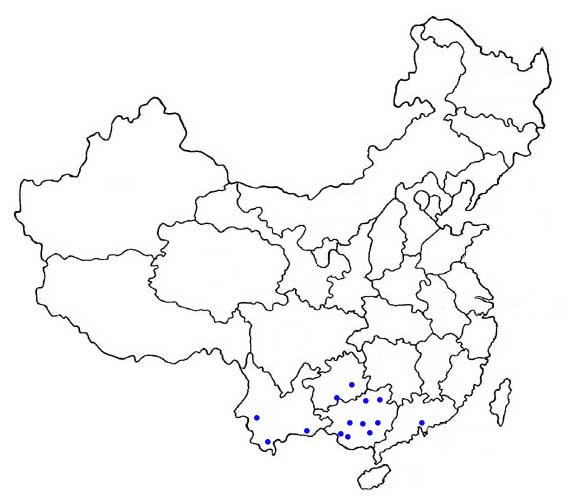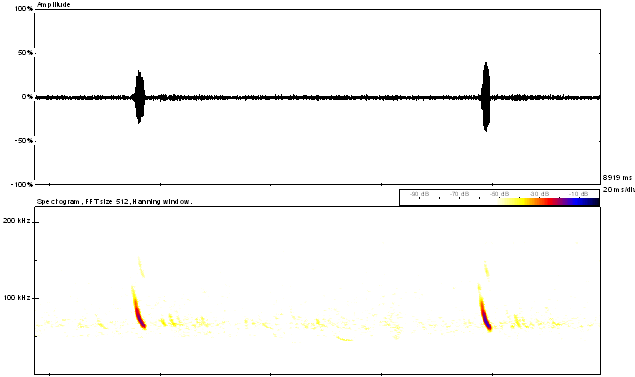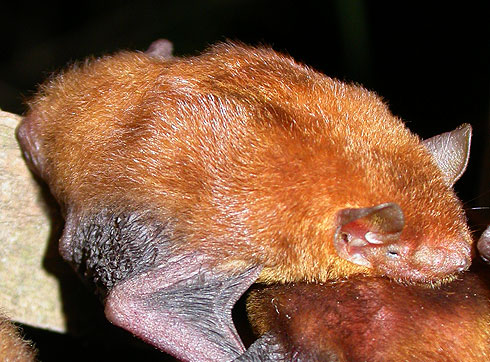Tylonycteris pachypus
Lesser Bamboo Bat
Morphological description Life history Distribution Habitat Roost sites and roosting patterns Emergence and flight pattern Foraging behaviour Echolocation calls Status and protection
Morphological Description
· The smaller of two sibling species of bamboo bats found in China.
· Dorsal and ventral fur is golden yellow.
· Forearm length 24.0 -28.0mm , average 25.5mm . Average wingspan is 190.2mm (Zhang et al. 2006).
· Skull is extremely flat, there are pads on digitoplantar (foot) and elbow joints, all these features being adaptations to roosting in bamboo stems.
· Average weight 3.4 g. (all the measurement data as given by Zhang et al., 2005).
Life history
· Birth dates between late May and early June in Guangxi. Gives birth to twins. Pups can fly when 22-25 days old (Zhang et al. 2005).
Distribution
This species is also found from India to the Andaman Islands, including Myanmar, Thailand, Malaysia, Indonesia and the Philippines (Bates & Harrison 1997). The Chinese distribution is shown by dots on the map (as given by Zhang et al. (1997).

Habitat
· Woodland and bamboo forests are typical habitat.
· In Guangxi, this bat live around villages.
Roost sites and roosting behaviour
· This bat does not hibernate, roosting within internodes of bamboo through the whole year.
· Lives sympatrically with T. robustula, but rarely roosts together within the same internode at the same time.
Emergence and flight pattern
· Emerges twice each night in dawn and dusk, normally foraging about twenty minutes each bout.
· Flight is relatively slow, with high manoeuvrability. Can hover briefly in front of bamboos.
· Wing span averaged 190 cm, wing area 5821 mm2, wing loading 5.7 Nm-2, aspect ratio 6.2 (Zhang et al. 2006).
Foraging behaviour
· Forages around trees and houses, along pathways through the bamboo forest and/or outside the forest, over the bamboo forest. An 'edge' species, though forages in more complex habitats than the larger and more heavily loaded T. robustula . Flight speed estimated at 4.3 m/s (Zhang et al. 2006).
· The diet mainly consists of Hymenoptera (53.4% by volume), and Diptera (29.0% by volume) and Coleoptera (13.4%). Small quantities of Hemiptera were found with traces of Homoptera, Blattodea and Embioptera (Zhang et al., 2005b). Has a narrower food-niche breadth than T. robustula , and eats smaller prey than that species (Zhang et al., 2005b).
Echolocation calls
Average values for greater bamboo bat echolocation calls, as given by Zhang et al. ( 2006), are listed below:
Interpulse interval: 55.4 ms
Call duration: 5.0 ms
Minimum frequency: 58.3 kHz
Maximum frequency: 129.2 kHz
The spectrogram shows clear frequency modulation, with the call beginning at high frequency and ending at a lower frequency, and ending with a more narrowband tail at times.
Analysis of power spectra shows that the maximum power of the call is at a frequency of approximately 65.1 kHz. The calls are therefore almost 10 kHz higher in peak frequency than those of T. robustula (Zhang et al. 2006).

The development of vocalizations in infants is described by Zhang et al. (2005a). Vocalizations serve as precursors of echolocation calls and as isolation calls, and mothers also produce directive calls when searching for infants.
Status and protection
· There is no estimation of population size in China for this species.
· Lesser bamboo bats are at LR/lc, assessed by the Red List of Threatened Species (IUCN, 2006) and are not listed in the Law of the People's Republic of China on the Protection of Wildlife in 1989. Widespread on a global scale and locally common in places.
· Bamboo forests should be protected as their habitats.
